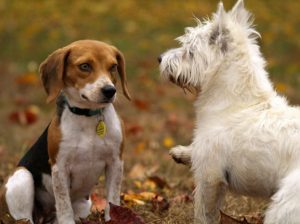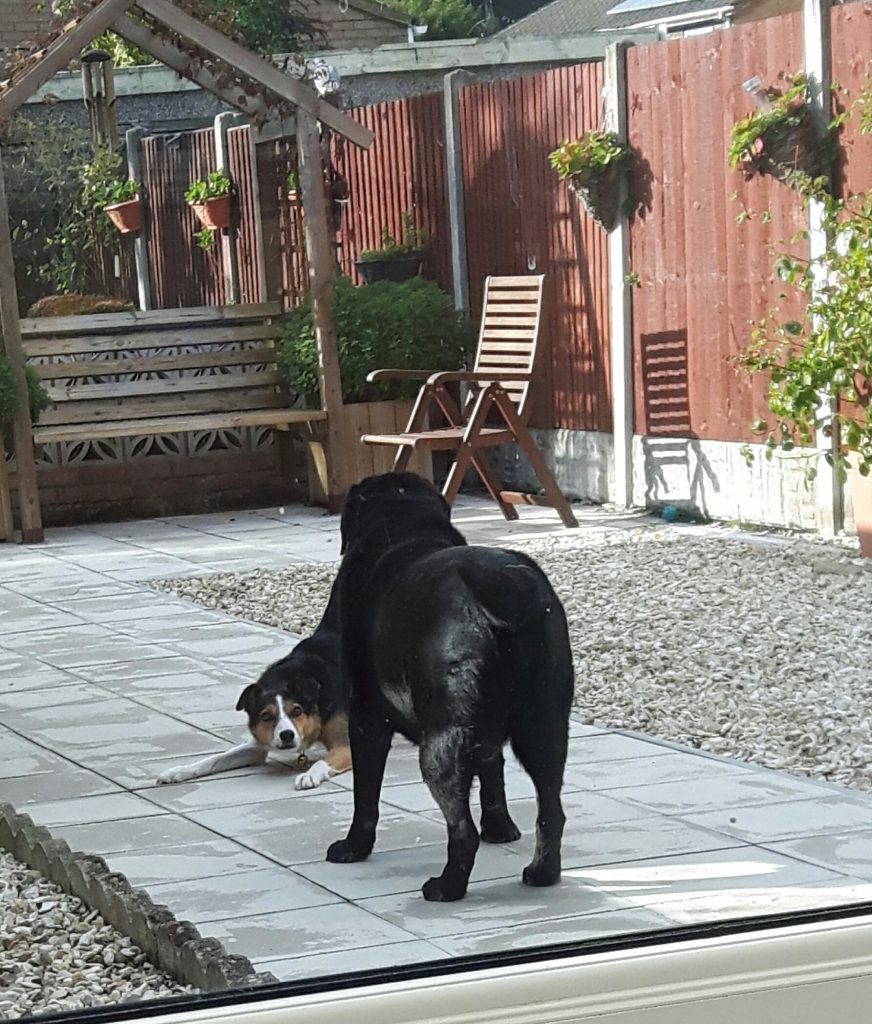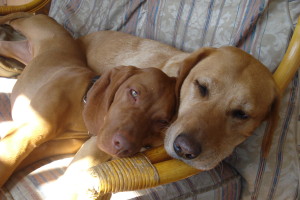Dog Bonding – How to Introduce Dogs to One Another
At Holidays4Dogs we have written frequently on the subject of the human-animal bond. But, what about friendship between dogs? How do dogs bond and what is the best way of introducing dogs to one another?
Dogs are social creatures that naturally live in groups or packs. However, the domestic dog bonds with his fellow canine companions very differently from wild dogs, or wolves, for example.
Wolves bond with each other in ways that are associated with shared interests such as hunting, or protection of the pack.  However, domesticated dogs tend to bond differently and it doesn’t always come naturally.
However, domesticated dogs tend to bond differently and it doesn’t always come naturally.
Some experts in the world of behavioural science even believe that dogs have evolved to form stronger attachments with humans, rather than other dogs.
Quite commonly families wish to introduce another dog into the family permanently or need their dog to get along with a friend’s, or relative’s dog, from time to time. However, it is important to foster a harmonious relationship. Bonding between two, (or more dogs), does not necessarily happen naturally, or immediately.
To get things off to a good start it’s always best to introduce the dogs on neutral territory. As dogs tend to be territorial, being faced with a sudden new-comer, might put some dogs off. This might be especially so if the dog has lived as an only dog for some time.
Canine communication
When puppies leave for their new lives in a new home, they are still learning the ropes of canine communication and don’t always get it right. Just like human children, puppies are not fully aware of the rules of social interaction. Having only had their litter mates to play with, they will often want to play with adult dogs in their new home with the same reckless abandon.
If you are bringing a new puppy home, keep your current dog on the lead and let the puppy wander around investigating of his own accord. If you are satisfied your adult dog is happy, allow him to greet the puppy. Rescue dogs can sometimes take longer to settle into new homes if other dogs are present. Many may lack social skills due to an abusive past, or a lack of socialisation.
Introducing a new puppy to an adult dog
An older dog may immediately want to play with the puppy, so if there is a size difference, monitor the situation in case the puppy becomes frightened. Equally, the existing dog, may want to back off. The same can be said, when introducing adult dogs. Don’t force interactions, but allow the dogs to become comfortable in their own time. Be patient, because sometimes it will take time for both dogs to relax – in some cases, weeks or, even months.
Adult dogs will usually communicate to puppies which behaviours are acceptable – and those which are not. For instance, an adult dog will generally not like his head being sat on, or having his tail pulled!
If the puppy oversteps the mark, you may find the older dog will growl, show his teeth or, ‘air snap’. The puppy will soon learn this is the signal for him to back off. After a while, when the puppy knows how to behave, the older dog will usually begin to show more interest in playing.
As much as it may be tempting to correct the adult dog if he growls, try to resist this temptation. Always supervise any interactions of this nature, but as long as the adult dog is not making contact with the puppy, let the pup learn that a growl means – “leave me alone”.
If he doesn’t listen to this warning, he may get snapped at. Usually, this is enough to stop a persistent pup, but if he still won’t leave the adult dog alone, provide both dogs with ‘time out’ so that you have the opportunity to calm the situation and give the adult dog the peace he needs.
Referee.
The most important thing owners can do is to always make sure they supervise interactions between puppies and other adult dogs in the household. Some puppies can be relentless in their pursuit of rough-and-tumble games. It would be unfair to expect an adult dog, especially if he is elderly, to put up with this. Sometimes, it is appropriate to intervene by using gates to separate the dogs. Always make sure both dogs have their own space.
There are a few dogs that simply won’t get along with puppies at all, so it is important to be vigilant and make sure things don’t get out of hand. If for instance, a pup squeals and yaps and the adult dog doesn’t back off, you must intervene. A squealing puppy should be the signal to an adult dog that he should back off – if he becomes more confrontational, remove him at once.
It is also wise to ensure the older dog is not making up the rules! This sounds odd, but while it is acceptable for the adult dog to correct a puppy during an interaction, ( i.e. being jumped on while sleeping), it is not acceptable for him to correct a puppy for running around the house, or engaging in some other activity where he is minding his own business.
First Introductions for adult dogs
Find a suitable place where both dogs can be introduced to one another. Ideally, away from too many other distractions. Walk the dogs together on the lead, in the same direction, side by side. If the dogs are happy to interact – let them sniff.
Encourage the dogs with plenty of praise for calm behaviour and interactions with each other – have a nonchalant and calm air yourself and try not to let the leads become taut, or tangled.
– have a nonchalant and calm air yourself and try not to let the leads become taut, or tangled.
Move introductions into the back garden of the resident dog and then into the house. Be mindful of the fact that the new dog may need space. Avoid allowing the existing dog to constantly follow the new dog around.
It’s important to provide second, or subsequent dogs, with their own space. Spend time with each dog separately. Don’t force the dogs to be together all the time as this is where tension can build, especially if they feel they have to compete for your attention. Dog crates can be useful for separating strange dogs for short periods when you cannot supervise them.
Allow the dogs plenty of time to play together. At the same time, make sure you supervise so that things don’t get too rough or out of hand. See our other Holidays4Dogs article on the subject of rough play.
Ideally, the existing dog should be fairly mature and well-trained before introducing other dogs into the family on either a temporary or permanent basis, such as in a
Conclusion
The majority of dogs will quickly adapt to having a new playmate. This is particularly so if they are already confident when meeting unfamiliar dogs on walks.
There will always be exceptions when introducing dogs to each other. However, even less confident dogs will usually warm to having another dog as a companion – it just may take a little longer for them to get used to it.
For information on introducing your dog to a new baby in the family, follow the link here. For our article on dogs and children click here.



